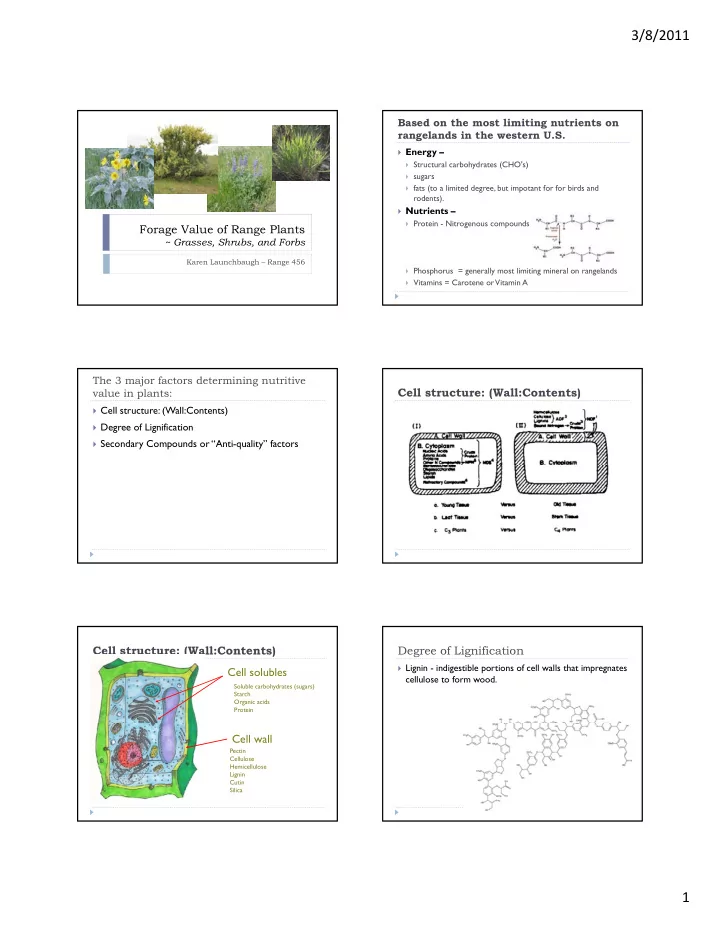

3/8/2011 Based on the most limiting nutrients on rangelands in the western U.S. � Energy – � Structural carbohydrates (CHO's) � sugars � fats (to a limited degree, but impotant for for birds and rodents). � Nutrients – N i � Protein - Nitrogenous compounds Forage Value of Range Plants ~ Grasses, Shrubs, and Forbs Karen Launchbaugh – Range 456 � Phosphorus = generally most limiting mineral on rangelands � Vitamins = Carotene or Vitamin A The 3 major factors determining nutritive Cell structure: (Wall:Contents) value in plants: � Cell structure: (Wall:Contents) � Degree of Lignification � Secondary Compounds or “Anti-quality” factors Cell structure: (Wall:Contents) Degree of Lignification � Lignin - indigestible portions of cell walls that impregnates Cell solubles cellulose to form wood. Soluble carbohydrates (sugars) Starch Organic acids Protein Cell wall Pectin Cellulose Hemicellulose Lignin Cutin Silica 1
3/8/2011 Secondary Compounds or “Anti-quality” factors Comparative Nutritive Value of Plant Parts � Plants may contain compounds or toxins that reduce � Fruits, seeds, root-crowns and flowers generally have forage quality or adversely affect the herbivore higher levels of cell contents (cell solubles) and are therefore more nutritious than leaves or stems. � Seeds also contain significant levels of fats Comparative Nutritive Value of Plant Parts Maturation Effects on Nutritive Quality: � Leaves are more nutritious � Most range plants are highly nutritious when young. Even than stems. plants that are normally considered undesirable (such as cheatgrass) are nutritious when young. � Why ? � More cell contents � As plants mature nutritive value decreases. � Less structural CHO's � Increased structural CHO's � Lignification � In shrubs, current seasons � Increasing Stem:Leaf Ratio growth is generally more nutritious than old growth. � Leaching of nutrients by rain in dormancy. � Why ? � Leaching is when rain washes soluble nutrients out of the � as stem age they become plant into the soil. Plants that resist leaching due to dry LIGNIFIED climate, morphology, or range site are said to "cure" well. Comparative Nutritive Value of Grasses, Comparative Nutritive Value of Grasses, Forbs, and Shrubs Forbs, and Shrubs � What is browse? � Nutrients - graph adapted from Parker 1969 The portion of shrubs used for forage. Generally, leaves & current seasons twigs. 2
3/8/2011 Comparative Nutritive Value of Grasses, C3 vs C4 Grasses Forbs, and Shrubs � During growing season - forbs are more nutritious than grasses (which are more nutritious than shrubs). Tropical grasses � This is because the cell wall of grasses is thicker than the cell wall (C4) are less of forbs. nutritious than � During dormant season - browse are important for temperate grasses nutrients. (C3) because they (C3) because they contain more schlerenchyma, epidermis, vascular tissue and cell walls are more lignified. Comparative Nutritive Value of Grasses, Comparative Nutritive Value of Grasses, Forbs, and Shrubs Forbs, and Shrubs � Energy - graph by Parker 1969 � During growing season - grasses, forbs, and shrubs all provide good amounts of energy � Durging dormant season - grasses provide a stable source of energy. Environmental Influences of Plant Anti-quality Agents: Nutritive Quality: � T emperature: � Most common in shrubs and forbs. (Rarely a problem in grasses). � Higher temperatures - decrease water soluble CHO's and protein levels. � Liginification and maturation occur more quickly at elevated � Inhibitors - may cuase illness but also inhibit digestion. temperatures. � Tannins - React with dietary proteins to form complexes resistent to � Moisture: microbial degradation. � Moderate moisture stress increases the nutritive value of plants by delaying maturation. � Phenolic - also decrease protein digestibility. � Severe moisture stress hastens translocation of nutrients to the � Essential Oils - can inhibit digestion (CHO's and protein by inhibiting roots and senescence. microbial growth). � Range Site: � Toxins - cause illness or death (ie. alkoloides ). Fertile soils may delay maturity and increase leaf:stem ratios. � � High level of soil Nitrogen may increase protein content of plants. 3
3/8/2011 Recap: Plant Management for Animal Nutrition � Forbs are important sources of protein and carotene � Monocultures provide high quality at one time of year. during the growing season. This may be useful in management such as spring grazing areas. � Shrubs are important to maintain phosphorus and protein levels in winter (dormant season). � A variety of forage classes on range provide nutrients � Grasses are important sources of energy (structural � Grasses are important sources of energy (structural throughout the year: CHO's) throughout the year. � Plants mature at different times during season � Forbs and shrubs may contain anti-quality agents which � Seasonal supply of nutrients is improved by having different decrease their nutritive value. classes of forage (grasses, forbs and browse). � Increased use of range by wildlife because not all animals eat the same thing. 4
Recommend
More recommend